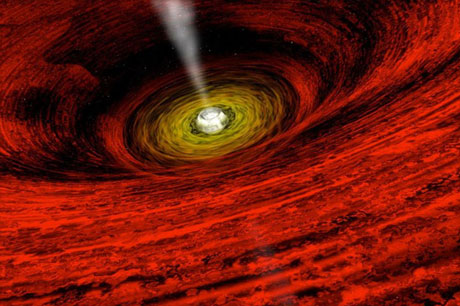A Flickering “Black Hole”
Source: Thunderbolts.info

Above: Illustration of the imagined effects of a black hole hidden in the center of the "accretion disk" GRO J1655.
Credit: A. Hobart, CXC
Astronomers claim that a celestial object called GRO J1655 hides a black hole. But why does its surrounding plasma flicker 450 times a second? Because the black hole is "rotating very rapidly," astronomers say.
Astronomers tell us that the "microquasar" at the center of GRO J1655 is seven times as massive as our Sun. It cannot be seen because it is a black hole formed from the collapse of an old star, now sucking in matter from surrounding space. Guided by nothing more than Einstein's view of gravity, the astronomers "know" it is there because of the energetic radiation and jets issuing from a very small region of space.
To derive the mass of a black hole, mathematicians divide the apparent energy from it by the puny gravitational force, which is almost zero compared to any other force, arriving at something just this side of an "infinite concentration" of mass. The escape velocity from such an object is greater than the speed of light. Therefore, neither particles nor radiation of any kind (including light) can be released into surrounding space. The black hole itself is invisible.
The calculations ignore all limitations posed by well-tested laws of physics. And when theorists discovered jets of charged particles speeding away from such objects, something was obviously wrong. So they adjusted their abstractions. A black hole has a theoretical boundary known as an "event horizon", within which gravity forever holds all matter and energy prisoner. It was suggested that just outside this boundary gravity could act on a rotating "accretion disk" to miraculously accelerate material away from the black hole (as "illustrated" in the drawing above). By this sleight of hand, the improbable jets -- in transparent contradiction of gravitational dogma
-- became more "evidence" for the hidden black holes.
With a blank check in hand, the pure mathematicians have had a field day.
GRO J1655-40 has two powerful jets of plasma rushing away from its poles at nearly the speed of light. The illustration above is said to depict both a polar jet and the surrounding accretion disk. But how this curious reversal of gravity's influence actually works is not yet clear, the theorists say.
Recent investigation has also found that GRO J1655-40 displays an unexpected flickering some 450 times a second. How would the mathematicians respond to something never envisioned by a model that worked only with mass, density, and rotation? Very simply. The hidden black hole must be rotating at an amazing 27,000 rpm, somehow creating an energetic "lighthouse" beam of radiation.
Though no one can really explain any of this, the authors of the Astronomy Picture of the Day are not dissuaded. "What physical mechanisms actually cause the flickering -- and a slower quasi-periodic oscillation (QPO) -- in accretion disks surrounding black holes and neutron stars remains a topic of much research."
Are readers confused? Or are astronomers themselves missing something?
Plasma experts knowledgeable in the role of electric currents in space continue to contrast the astronomers' abstractions with observational and experimental evidence. Across vast distances in space, plasmas carry electric currents, and at those focal points where currents pinch down to form stars, infrequent but catastrophic releases of energy may occur.
The electrical theorists say that the most fundamental mistake of astronomers and cosmologists is their habit of seeing celestial objects in isolation. It is this habit that drives them to conjure exotic forces and events limited to the vicinity of the objects themselves, in order to explain such phenomena as plasma "flickering."
As noted by plasma scientist Anthony Peratt, in electric discharges flickering electromagnetic radiation is commonplace. "The flickering comes from electrical changes at the observed load or radiative source, such as the formation of instabilities or virtual anodes or cathodes in charged particle beams that are orders of magnitude smaller than the supply." (I.e., in space the electrical supply comes from regions incomparably larger than the visible phenomenon, which is incapable of explaining itself.) So if a flickering is interpreted by a distant observer to be both the "source and supply," Peratt notes, the results will not only be bizarre, they will lack a basis in any verifiable physics.
Sadly, the convoluted dogma of black holes fits this description perfectly.
See also "The Madness of Black Holes," by Wallace Thornhill:
http://www.holoscience.com/news.php?article=9kpgc4td
POSTSCRIPT: The full 64 minute documentary film "Thunderbolts of the Gods" can now be viewed for free on Google video:
http://video.google.com/videoplay?docid=
4773590301316220374&q=thunderbolts+of+the+gods&hl=en





















